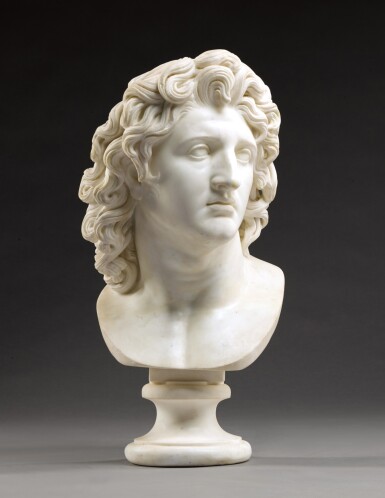
Italian, Rome, 18th century
Bust of Alexander the Great
Lot Closed
October 19, 02:05 PM GMT
Estimate
15,000 - 20,000 GBP
Lot Details
Description
Italian, Rome, 18th century
After the Antique
Bust of Alexander the Great
white marble
60 cm., 23⅝ in.
Christie's Melbourne, 28-29 May 2001, lot 458;
Lex Aitken & Alfredo Bouret Gonzalez, 39 Brook Street, Mayfair;
their sale, Christie's South Kensington, 4 June 2014, lot 166
The portrait of the infamous Macedonian king Alexander the Great has enthralled both artists and audiences for centuries. Described by Arrian as a 'strong, handsome commander with one eye dark as the night and one blue as the sky’, the enigmatic hero launched a series of military and political campaigns throughout India, Mesopotamia, and Asia Minor, diffusing Hellenic culture across three continents and forging a vast empire which forever altered the dynamic of the ancient world.
The widely recognisable sculptural portrait of Alexander as the inspired ruler, typified by his youthful, beardless face and his tousled leonine hair swept upwards from the forehead (anastole), was first established by Lysippus. Plutarch records that 'it was by this artist alone that Alexander himself thought it fit that he should be modelled’. Nothing survives from this Greek sculptor’s body of work, but an extant Roman copy known as The Azara Herm, now in the Louvre, is considered to be the closest likeness to the original Lysippan portrait of the King.
The present bust exudes quality, from the beautifully polished skin to the drilled and carved mass of hair, which is characterised by a sense of weight and plasticity. Gazing to the left, with classically rounded chin and lips pursed, we may conclude that this model is based upon a Roman copy of the third century B.C., now housed in the Capitoline Museum in Rome. The original bust was displayed in the Sala delle Colombe in the Vatican until 1797, before moving to the Stanza del Gladiatore in 1817. Further stylistic resemblance is apparent in the head of the Dying Alexander in the Uffizi, Florence.
RELATED LITERATURE:
J. J. Pollitt, Art in the Hellenistic Age, Cambridge, 2006, pp. 20-22
